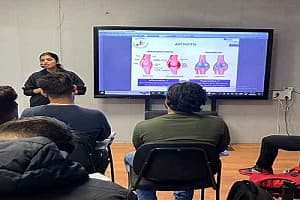A Review Article on Fats: Introduction, Types, Obesity, Health Risks, and Causes
Created On: Apr 13, 2021

Dr. Chirag Sethi* and Dr. Swarna Anchal**
*Director, Classic Fitness Academy, New Delhi
**Technical Writer, Classic Fitness Academy, New Delhi
Introduction
The terms fat and lipid are interchangeable. Fat cells are also called adipocytes or lipocytes because they are composed of adipose tissue and the adipose gene is responsible for their production. Fat cells perform various significant functions in the human body such as providing structure for cell membranes, insulating and protecting vital organs, regulating endocrine system function, helping transport vitamins and minerals around the body, and as a source of energy for many cellular functions. Fats provide 9 calories of energy per gram while proteins and carbohydrates each produce 4 calories per gram. Fat is stored in the body at various places such as skin (subcutaneous), around internal organs (Visceral fat), bone marrow, inter-muscular, and breast tissue. There are two types of fat cells:
White adipose Cells: Mainly found in adults. They contain a single large lipid droplet and composed of triglycerides and cholesterol. These cells secrete many hormones such as resistin, leptin, and apelin, and also store energy. An average human adult has 30 billion fat cells with a weight of 30 lbs or 13.5 kg. If excess weight is gained as an adult, fat cells increase in size (Figure 1).
Brown adipose Cells: Mainly found in newborns that's why also called 'baby fat' and used to generate heat. Brown fat cells have several lipid droplets scattered throughout as compared to white fat cells. The brown color comes from a large number of mitochondria in it (Figure 2).

Fat Metabolism
Lipolysis is the breakdown of fats into fatty acids and glycerol to produce adenosine triphosphate (ATP), which is the chemical that fuels muscle activity. When the body needs energy for physical activity, the sympathetic hormone nor-epinephrine acts with receptor cells in adipose tissue to release the enzyme lipase, which breaks down fats into Acetyl Co-A via beta-oxidation.
In mitochondria, these Acetyl Co-A is used in the production of ATP molecules via the electron transport chain. ATP molecules are the energy currency of the body and are used in all biological processes.
The result is that the three fatty acids and one glycerol can produce 457 molecules of ATP. By comparison, glycolysis (the conversion of glycogen to ATP) yields 36 ATP molecules per one unit of glucose. Lipolysis is a slower process, which explains why it is the dominant source of energy during periods of rest or low-intensity physical activities.

Fat deposition
Fat is distributed beneath the skin all over the body and sometimes we can see some parts of the body have more fat than other parts. Generally, most body fat exists in the stomach and thigh areas, thus both can determine the shape of a person’s body. Understanding your body shape could help you in improving your health. There are so many factors that can determine our body shape: genetics, lifestyle, sex, and age. Some people tend to accumulate weight around the hip, others on the belly. Based on the overall fat distribution in your body, most people can fall into these body shape categories, Apple (Android) Shape and Pear (Gynoid) Shape.
(1) Apple or Android Shape
Apple shape is generally associated with males. If a person has an “apple-shaped” body, weight accumulates around his hips and abdomen. The person will be wider at the upper body but narrower by the lower body part. His W/H (waist to hip ratio) will be greater than 0.95 inches. This body shape indicates lifestyle imbalances such as high levels of stress, poor diet, and very little physical activity. In men particularly, excessive consumption of alcohol has been linked to the development of the apple-shaped figure. Weight accumulates around hips and abdomen, increased risk of cardiovascular diseases, Type 2 Diabetes, and Elevated Blood Pressure.
(2) Pear or Gynoid Shape
The pear shape is mostly associated with females and they will have a figure that is opposite from apple-shaped people means the hip section will be wider than the upper body. Most of the fat is deposited around the thighs, and hips region. Their W/H (waist to hip ratio) will be greater than 0.80 inches. Shoulders will be narrower than the hips. Weight carried around the bottom and thighs is due to subcutaneous fat rather than the more dangerous visceral variety. Carrying extra weight on the hips can lead to an increased risk of osteoarthritis. Scientific research has also shown that pear body shapes may find it more difficult to lose weight than those with an apple shape.

Obesity
Obesity is a complex disease involving an excessive amount of body fat. Body mass index (BMI) is a calculation that takes a person’s weight and height to measure body size. In adults, obesity is defined as having a BMI of 30.0 or more. Obesity is associated with a higher risk for serious diseases, such as type 2 diabetes, heart disease, and cancer.

Types of obesity
Obesity is of three different types based on causes, location, and according to size, and number as shown in the table:

Health Risks Associated with Obesity
Obesity doesn’t mean that person will develop the following health problems but it increases the chances of developing one or more of them. Here are 10 health risks associated with obesity.
Type 2 diabetes: It occurs when the blood sugar level is higher than normal. Over time, this can lead to other health issues, like heart disease, nerve damage, stroke, kidney disease, and vision problems. If someone is obese and s/he loses just 5 to 7% of body weight by regular and moderate exercise, it may prevent or delay the onset of type-2 diabetes.
Heart disease: is more prevalent in people with obesity. Over time, fatty deposits may accumulate in the arteries that supply the heart with blood. People with obesity have higher than normal blood pressure, low-density lipoprotein (LDL) cholesterol, triglycerides, and blood sugar, all of which contribute to heart disease. Arteries that become narrow can lead to a heart attack. Blood clots in narrow arteries can result in a stroke.
Stroke: Stroke and heart disease share many of the same risk factors. Strokes occur when the blood supply to the brain is cut off. A stroke can cause damage to brain tissue and result in a range of disabilities, including speech and language impairment, weakened muscles, and changes to thinking and reasoning skills.
Sleep apnea: is a disorder in which someone may momentarily stop breathing during sleep. People who are overweight and living with obesity are at a higher risk of having sleep apnea. This is because they tend to have more fat stored around the neck, making the airway shrink.
High blood pressure: Extra fat tissue in the body requires more oxygen and nutrients. Your blood vessels will need to circulate more blood to the extra fat tissue. This means the heart must work even harder to pump blood around the body. It increases the pressure on the walls of arteries. This added pressure is called high blood pressure, or hypertension. Over time, high blood pressure can damage your heart and arteries.

Liver disease: People with obesity can develop a liver disease known as fatty liver disease or nonalcoholic liver disease (NALD). This happens when excess fat builds up in the liver. The excess fat can damage the liver or cause scar tissue to grow, known as cirrhosis, and can eventually lead to liver failure.
Depression: Many people affected by obesity experience depression. People affected by obesity may often experience discrimination based on their body size.
Causes of Obesity
There are so many factors that lead to obesity and these include environmental, genetic, behavioral, social, mental, and physical, drugs, and hormones as shown in the picture. Obesity is due to a sedentary lifestyle, absence of physical activity, and consumption of foods that are high in salt and sugar content. High advertising and marketing of junk foods are also responsible to attract people towards them and eating junk foods more frequently. This comes under environmental factors.
An unhealthy lifestyle also invites other metabolic disorders such as hypothyroidism, polycystic ovaries, diabetes which are interlinked to obesity.
Sometimes genetic factors can also lead to obesity such as Prader-Villi syndrome.
Hormones responsible for obesity are insulin, leptin, grehlin which control our apatite and provide signals of the fullness of the stomach. Any impairment in their functioning can lead to obesity.

References
(1) Birbrair A, Zhang T, Wang ZM, Messi ML, Enikolopov GN, Mintz A, Delbono O (2013). Role of pericytes in skeletal muscle regeneration and fat accumulation. Stem Cells and Development. 22(16):2298–314.
(2) Kershaw EE, Flier JS (2004). Adipose tissue is an endocrine organ. The Journal of Clinical Endocrinology and Metabolism 89(6):2548–56.
(3) Cannon B, Nedergaard J (2008). Developmental biology: Neither fat nor flesh. Nature 454(7207):947–48.
(4) Bachmanov AA, Reed DR, Tordoff MG, Price RA, Beauchamp GK (2001). Nutrient preference and diet-induced adiposity in C57BL/6ByJ and 129P3/J mice. Physiology & Behavior 72(4):603–13.
(5) Cinti S (2005). The adipose organ. Prostaglandins, Leukotrienes, and Essential Fatty Acids 73(1):9–15.
(6) Wirth A, Wabitsch M, Hauner H (2014). The Prevention and Treatment of Obesity. Deutsches Ärzteblatt International 111(42):705–713.
(7) Nagai M, Komiya H, Mori Y, Ohta T, Kasahara Y, Ikeda Y (2010). Estimating visceral fat area by multifrequency bioelectrical impedance. Diabetes Care 33(5): 1077–79.
(8) Ohkawara K, Tanaka S, Miyachi M, Ishikawa-Takata K, Tabata I (2007). A dose-response relation between aerobic exercise and visceral fat reduction: a systematic review of clinical trials. International Journal of Obesity 31(12):1786–97.
(9) Brown JC, Harhay MO, Harhay MN (2016). Anthropometrically predicted visceral adipose tissue and blood-based biomarkers: a cross-sectional analysis. European Journal of Nutrition 57(1):191–198.
(10) Atzmon G, Yang XM, Muzumdar R, Ma XH, Gabriely I, Barzilai N (2002). Differential gene expression between visceral and subcutaneous fat depots. Hormone and Metabolic Research 34(11–12):622–28.
(11) Cannon B, Nedergaard J (2004). Brown adipose tissue: function and physiological significance. Physiological Reviews 84(1):277–359.






